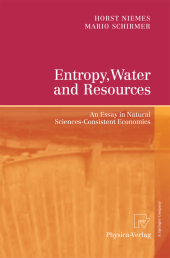 Neuerscheinungen 2014Stand: 2020-02-01 |
Schnellsuche
ISBN/Stichwort/Autor
|
Herderstraße 10
10625 Berlin
Tel.: 030 315 714 16
Fax 030 315 714 14
info@buchspektrum.de |

Horst Niemes, Mario Schirmer
(Beteiligte)
Entropy, Water and Resources
An Essay in Natural Sciences-Consistent Economics
2010. 2014. ix, 219 S. 235 mm
Verlag/Jahr: PHYSICA-VERLAG 2014
ISBN: 3-7908-2931-5 (3790829315)
Neue ISBN: 978-3-7908-2931-0 (9783790829310)
Preis und Lieferzeit: Bitte klicken
This book lies at the intersection of natural sciences, economics, and water en- neering and is in line with the long tradition of environmental economics at the University of Heidelberg. In the 1970s, the Neo-Austrian Capital Theory was developed using the fundamental laws of thermodynamics as a common language between the natural and social sciences. Niemes (1981) integrated the dynamic and irreversibility characteristics of the natural environment into the Neo-Austrian c- ital theory. Faber et al. (1983, 1987, 1995) then extended this interdisciplinary approach further to create a comprehensive, dynamic, environmental resource model. Over the last 3 decades, the theoretical foundations of environmental economics have been modi ed and there have been an impressive variety of applications. This book aims to reduce the gaps between economic theory, natural sciences, and engineering practice. One of the reasons these gaps exist is because economic assumptions are used to construct dynamic environmental and resource models, which are not consistent with the fundamental laws of the natural sciences. Another reason for the gap might be the distance between academic theory and real world situations. Based on an extended thermodynamic approach, the authors explain which economic assumptions are acceptable for constructing a dynamic model that is consistent with the natural sciences. In particular, the special role of water in the production and reproduction activities will be considered as an integral component.
The Water Use Model.- Conceptual Foundations: Thermodynamics and Capital Theory.- General Design of Dynamic Models for Water Uses.- Specifications for Constructing the Water Use Model.- Constraints of the Water Use Model.- Optimality Conditions of the Water Use Model.- The Water Infrastructure Model.- Case Studies Guiding the Integration of Water Infrastructure.- Specifications for Constructing the Water Infrastructure Model.- Constraints of the Water Infrastructure Model.- Optimality Conditions of the Water Infrastructure Model.


